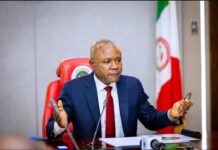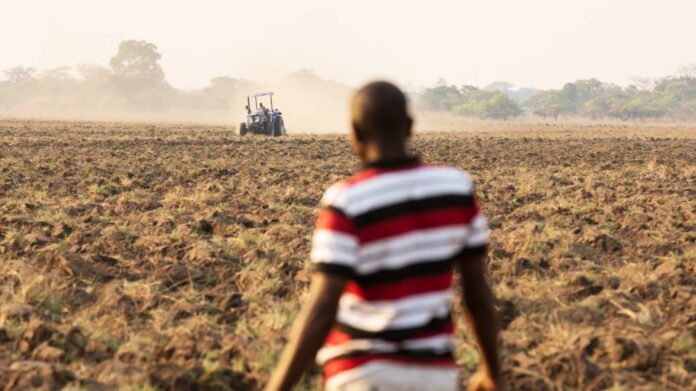Ethiopia has long benefited from close ties to the West, China and emerging powers. In 2004 Western and multilateral creditors wrote off more than $3bn of its debts. Since 2000 it has received more loans from China than any other African country except Angola. In 2014 it borrowed on international capital markets for the first time. Asian manufacturers set up factories in industrial parks with the aim of using Ethiopia’s duty-free access to Western markets. More recently it has received billions of dollars in investment from the United Arab Emirates (UAE). Though the atrocious civil war in Tigray caused the West to suspend some ties, there was a reset in 2024, with the imf and World Bank announcing new loans last July.
Yet the architect of many of the reforms which attracted those institutions is concerned about the headwinds faced by African countries. Mamo Mihretu, Ethiopia’s central-bank governor, worries that net financial flows—the balance between the amount received in loans from overseas and the amount going out in debt repayments—have turned negative for many African countries. It is a clear sign of how hard it is to attract the new investment they need. “This is the biggest story that nobody is paying attention to,” argues Mr Mihretu.
To match the sort of capital flows that led to East Asian economic booms, Africa would need to roughly double investment as a share of gdp from its current level of around 16%. The African Development Bank (afdb) has a similar figure, estimating that the continent needs to close an annual financing gap of $400bn, or almost 14% of its gdp, to “accelerate its structural transformation process”.
Until recently, the 21st century appeared a benign time for Africa in international affairs. China’s rise fuelled demand for its natural resources. Globalisation encouraged investors into emerging and “frontier” markets. Widespread debt relief in the mid-2000s gave governments room to borrow. They took out loans not just from the World Bank and Western governments but from commercial creditors. Between 2007 and 2020, 21 African countries borrowed on global capital markets, many for the first time. China became the largest official bilateral creditor, lending more than $180bn since 2000, according to the Chinese Loans to Africa database managed at Boston University.
China whirl
The world seems less forgiving these days. Geopolitical tensions mean that sub-Saharan Africa may get stuck in the middle of economic competition between the West and China. African leaders may hope to play one side off against the other. But since the region trades roughly as much with China as it does with America and Europe combined, any decoupling of the two blocs into separate trading areas will be bad news. An imf paper in 2024 suggested that, in such a scenario, the median sub-Saharan African country would face a permanent decline of 4% in real gdp. No other region would be hurt as much.
It is also harder than it was for most African countries to raise financing. This is to some extent a problem of Africans’ own making. After the debt relief of the 2000s, states borrowed heavily. Debt to gdp in sub-Saharan Africa has doubled over the past 15 years. Poor countries need to borrow to pay for infrastructure to help them become less poor. But in Africa debts are growing faster than output and productivity.
fdi in Africa in 2023 was just $53bn, or 4% of the global total
Now governments are spending more scarce revenue on paying off old debts. Since 2022 a higher share of government revenues has gone on servicing debts than on health. The median share in Africa is 14% and in 13 countries it is more than 20%. Principal and interest payments are expected to rise as a share of gdp across sub-Saharan Africa in 2025, says the imf, which has warned that Africa faces a big funding squeeze. Some bright spots, such as Ivory Coast, have refinanced their debt by returning to capital markets. But interest rates on “eurobonds” (debt issued in a foreign currency) are one to four percentage points higher than before the covid-19 pandemic. Kenya, for instance, issued a bond at 10% interest rate in February 2024 to pay off an older eurobond due a few months later. It thus risks piling up problems for the future.
Other sources of capital are relatively scarce. Chinese lending to Africa peaked at $28.8bn in 2016. In the 2020s it has averaged $2.5bn per year (the pandemic played a role). Foreign-direct investment in Africa in 2023 was just $53bn or 4% of the global total, less in nominal terms than a decade previously. In 2022 the share of aid from rich countries going to Africa was at its lowest level since at least 2000.
Around half of African countries have “macro-imbalances” of some sort, notes the imf. And the lack of investment in future sources of growth, like education, infrastructure or research and development, means that Africa looks likely to fall further behind. On current trends it seems implausible that it can attract the game-changing investment sums it needs.
What might change this? Even a small increase in the share of global private capital going to Africa could make a big difference. (Between 2013 and 2021 Africa accounted for just 0.5% of the global private-equity market.) There is a debate about whether investors neglect Africa because they think it is riskier than it is. Ignorance about the continent’s diversity means that what happens in the most fragile states can affect would-be investors’ opinions about, say, Kenya. Data suggest the default risk of African infrastructure projects is lower than in Asia and Latin America.
For major investors Africa remains too small and too fragmented
But that is only one sort of risk—and infrastructure is only one class of investment. Analysis by the imf suggests that, though African sovereigns attract higher interest rates than other developing countries, the spread can be explained by factors such as a lack of transparency about spending and borrowing. Other sorts of investment, say, in local firms, are vulnerable to big currency devaluations and difficulties repatriating profits. Then there is the risk of operating in countries where politics and business are entwined. A veteran investor says: “I know it’s popular to say that Africa is misperceived but what’s the time value of bullshit? The risk is real. Africa is a high-friction place.”
And the lack of reward can be as important as the presence of risk. For major investors Africa remains too small and too fragmented. Bright Simons of Imani, a think-tank in Ghana, says, “There’s still a lot of room for the global investor to ignore Africa. There’s still a lot of other places to go.”
What about China? At the latest triennial Africa-China summit, President Xi Jinping announced $50bn in financing over the next three years. There is less to the figure than meets the eye. Some $10bn will go to Chinese firms in Africa; $30bn is in the form of vague “credit lines”. At the summit there was talk about how “small is beautiful”. But big is needed.
Middle powers may fill some of the gap. Turkish arms and construction firms are winning more contracts. The UAE is by some measures the fourth-largest source of fdi in Africa, after China, the eu and America. It and other Gulf countries have deposited hard currency in central banks facing liquidity problems. Yet the economic influence of many middleweight powers can be exaggerated. The eu imports 33 times more from sub-Saharan Africa than Russia does.
African leaders are calling for more money from customary sources. In 2024 they wanted donors to increase funding for the World Bank’s vehicle for poor countries, the International Development Association (ida), to $120bn over the next three years, from $93bn in the previous window. The total announced in December was $20bn shy of that target. Donald Trump’s administration could bring in officials sceptical of the very idea of the World Bank.
Some African policymakers have latched onto climate finance as a chance to direct more cash their way. But “the dirty secret of climate finance is that much of it is displacing traditional development aid,” says Vijaya Ramachandran of the Breakthrough Institute, an American think-tank. care, an ngo, believes half of climate finance provided by 23 rich countries from 2011 to 2020 was money that previously went on funding for areas like health, education and women’s rights.
And the money that does go to poor countries for climate change is mostly on mitigation, not adaptation, despite the small impact that Africa has on emissions. ida-eligible countries are responsible for 0.5% of current emissions and much less of historical ones. There is a risk that fiscally constrained countries are being encouraged to take on more debt for projects that divert their resources from growth. The West’s approach to aid and climate in Africa is like “banning buses in poor neighbourhoods while subsidising private jets for the rich”, says Ms Ramachandran.
Outsiders can help in other ways besides aid, such as clamping down on tax havens and making it easier for African firms to sell their goods overseas. China has promised “green lanes” to facilitate more agricultural exports, but commercial farmers complain of arduous regulations. America’s African Growth and Opportunity Act granting African countries tariff-free access could be expanded, for example by offering negative tariffs to incentivise exporters, by making services eligible, and cutting regulations on agricultural exports. Even if all that is unlikely under a tariff-loving President Trump, his government could boost America’s Development Finance Corporation, a $60bn fund for investments in poor countries’ private sectors, set up during his first administration.
Geopolitics may encourage great-power competition that Africans can exploit. But rising nationalism and protectionism bode ill. It would be naive to think the world will be kinder to Africa. If the continent is to close the gap it will have to do the hard work itself.
THE ECONOMIST





